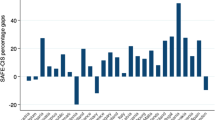Abstract
The role which the technological regime and learning play in determining the extent of industry turbulence, or the amount of firm movements into, within, and out of an industry, is examined. The entrepreneurial regime, in which firms outside of the industry incumbents have the innovative advantage, is found to promote industry turbulence. By contrast, the routinized regime, in which the existing incumbents have the innovative advantage, is identified as impeding industry turbulence. The determinants of small-firm turbulence are found to differ from those for large-firm turbulence. Small-firm turbulence is particularly high in capital-intensive industries, where firms must quickly learn or else face extinction.
Similar content being viewed by others
References
Acs, Zoltan J. and David B. Audretsch, 1990, Innovation and Small Firms, Cambridge, MA: MIT Press.
Acs, Zoltan J. and David B. Audretsch, 1989a, ‘Small-Firm Entry in U.S. Manufacturing”, Economica 56, 255–265.
Acs, Zoltan J. and David B. Audretsch 1989b, ‘Births and Firm Size’, Southern Economic Journal 55, 467–475.
Acs, Zoltan J. and David B. Audretsch, 1988, ‘Innovation in Large and Small Firms: An Empirical Analysis’, American Economic Review 78, 678–690.
Acs, Zoltan J. and David B. Audretsch, 1987, ‘Innovation, Market Structure and Firm Size’, Review of Economics and Statistics 69, 567–575.
Arrow, Kenneth J., 1962, ‘Economic Welfare and the Allocation of Resources for Invention’, in R. R. Nelson (ed.), The Rate and Direction of Inventive Activity, Princeton, NJ: Princeton University Press, 609–626.
Audretsch, David B. and Zoltan J. Acs, 1990, ‘Innovation as a Means of Entry: An Overview’, in P. Geroski and J. Schwalbach (eds.), Entry and Market Contestability: An International Comparison, London: Basil Blackwell.
Beesley, M. E. and R. T. Hamilton, 1984, ‘Small Firms' Seedbed Role and the Concept of Turbulence’, Journal of Industrial Economics 33, 217–232.
Berry, C. H., 1974, ‘Corporate Diversification and Market Structure’, The Bell Journal of Economics 5, 196–204.
Boden, Richard and Bruce D. Phillips, 1985, ‘Uses and Limitations of USEEM/USELM Data’, Office of Advocacy, U.S. Small Business Administration, Washington, DC, November.
Bolton Report, 1971, Commitee of Inquiry on Small Firms, Cmnd 4811, London: HMSO.
Bond, Ronald S., 1975, ‘Mergers and Mobility among the Largest Manufacturing Corporations’, The Antitrust Bulletin 20, 505–519.
Boyle, Stanley E., 1971, ‘Large Industrial Corporations and Asset Shares: Comment’, American Economic Review 61, 163–167.
Boyle, Stanley E. and Robert L. Sorenson, 1971, ‘Concentration and Mobility: Alternative Measures of Industrial Structure’, Journal of Industrial Economics 19, 118–132.
Caves, Richard E. and Michael Porter, 1977, ‘From Entry to Mobility Barriers’, Quarterly Journal of Economics 91, 241–261.
Collins, Norman R. and Lee E. Preston, 1961, ‘The Size Structure of the Largest Industrial Firms’, American Economic Review 51, 986–1011.
Evans, David S., 1987a, ‘The Relationship Between Firm Growth, Size, and Age: Estimates for 100 Manufacturing Industries’, Journal of Industrial Economics 35, 567–581.
Evans, David S., 1987b, ‘Tests of Alternative Theories of Firm Growth’, Journal of Political Economy 95, 657–674.
Gort, Michael and Steven, Klepper, 1982, ‘Time Paths in the Diffusion of Product Innovations’, Economic Journal 92, 630–653.
Grossack, I. M., 1965, ‘Towards an Integration of Static and Dynamic Measures of Industry Concentration’, Review of Economics and Statistics 47, 301–308.
Gudgin, G., 1978, Industrial Location Processes and Regional Employment Growth, Farnborough: Saxon House.
Helmstädter, E., 1986, Dynamischer Wettbewerb, Wachstum und Beschäftigung’, in Gottfried Bombach, Bernhard Gahlen, and Alfred E. Ott (eds.), Technologischer Wandel—Analyse und Fakten, Schriftenreihe des Wirtschaftswissenschaftlichen Seminars Ottobeuren, Tübingen.
Jovanovic, Boyan, 1982, ‘Selection and Evolution of Industry, Econometrica 50, 649–670.
Kamerschen, David R., 1971, ‘Large Industrial Corporations and Asset Shares: Comment’ American Economic Review 61, 160–162.
Kaplan, A. D. H., 1954, Big Enterprise in a Competitive System, Washington, DC: The Brookings Institution.
Marshall, Alfred, 1920, Principles of Economics 8th ed., London: Macmillan.
Mermelstein, David, 1971, ‘Large Industrial Corporations and Asset Shares: Reply’, American Economic Review 61, 168–174.
Mueller, Dennis C., 1976, ‘Information, Mobility, and Profit’, Kyklos 29, 419–448.
Mueller, Dennis C. and J. Tilton, 1969, ‘Research and Development Costs as a Barrier to Entry’, Canadian Journal of Economics 2, 570–579.
Oster, Sharon, 1982, ‘Intraindustry Structure and the Ease of Strategic Change’, Review of Economics and Statistics 64, 376–383.
Pakes, A. and Ericson, R., 1987, ‘Empirical Implications of Alternative Models of Firm Dynamics’, manuscript, Department of Economics, University of Wisconsin-Madison.
Porter, Michael E., 1976, Interbrand Choice, Strategy and Bilateral Market Power, Cambridge, MA: Harvard University Press.
Scherer, F. M., 1990, ‘Changing Perspectives on the Firm Size Problem’ in Z. J. Acs and D. B. Audretsch (eds.), Innovation and Technological Change: An International Comparison, Ann Arbor, MI: University of Michigan Press.
Scherer, F. M., 1980, Industrial Market Structure and Economic Performance, 2nd ed., Chicago, IL: Rand McNally College Publishing Co.
Simon, Herbert A. and Charles P. Bonini, 1958, ‘The Size Distribution of Business Firms’, American Economic Review 48, 607–617.
Stigler, George J., 1956, ‘The Statistics of Monopoly and Mergers’, Journal of Political Economy 64, 33–40.
Stiglitz, Joseph E., 1987, Technological Change, Sunk Costs, and Competition’, Brookings Papers on Economic Activity, 883–937.
Tilton, J., 1971, International Diffusion of Technology: The Case of Semiconductors, Washington, DC: The Brookings Institution.
Williamson, Oliver E., 1975, Markets and Heirarchies, New York, NY: Macmillan Publishing Co.
Winter, Sidney G., 1984, ‘Schumpeterian Competition in Alternative Technological Regimes’, Journal of Economic Behavior and Organization 5, 287–320.
Author information
Authors and Affiliations
Rights and permissions
About this article
Cite this article
Audretsch, D.B., Acs, Z.J. The entrepreneurial regime, learning, and industry turbulence. Small Bus Econ 2, 119–128 (1990). https://doi.org/10.1007/BF00389672
Issue Date:
DOI: https://doi.org/10.1007/BF00389672




